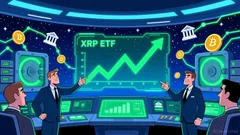AInvest Newsletter
Daily stocks & crypto headlines, free to your inbox
The Federal Reserve’s May 2025 decision to hold rates steady at 4.25%-4.5% amid rising tariff-induced inflation risks and labor-market resilience has created a pivotal moment for investors. With markets pricing in one to four rate cuts by year-end and the Fed’s forward guidance leaning toward caution, now is the time to pivot portfolios toward inflation-resistant assets while shedding exposure to trade-sensitive sectors. This article outlines a tactical strategy to capitalize on shifting macro risks.
The Fed faces a precarious balancing act: inflation remains elevated (core PCE at 2.6%), while trade tariffs threaten to exacerbate prices and slow growth. The May policy statement explicitly flagged “increased uncertainty” about the economic outlook, with Chair Powell acknowledging risks of stagflation—a toxic mix of rising prices and stagnant growth. Crucially, the Fed’s “wait-and-see” stance suggests no immediate rate hikes, but it has not ruled out further cuts if growth falters.
This ambiguity creates a two-pronged opportunity:
1. Inflation Hedge: Commodity-linked assets and Treasury Inflation-Protected Securities (TIPS) can buffer against tariff-driven price surges.
2. Sector Rotation: Rotate out of trade-exposed industries and into sectors insulated from global supply chain disruptions.

The Fed’s pause and labor-market resilience (unemployment at 4.2%) argue against a full-on market collapse, but sector differentiation is critical.
Even with sector rotation, macro risks demand further hedging:
1. Short Trade-Sensitive Equities: Use inverse ETFs like SKF (short financials) or SDS (short S&P 500) to bet against sectors disproportionately exposed to tariff fallout.
2. Commodity Futures: Direct exposure via crude oil (USO) or copper (JJC) can hedge against supply chain disruptions.
3. Dollar Exposure: A weaker dollar (if tariffs trigger capital flight) could benefit inverse USD ETFs like UDN.
The Fed’s pause has bought investors time to reallocate, but the window is narrowing. With inflation risks rising and trade tensions unresolved, portfolios must prioritize resilience over growth. By rotating into commodities, TIPS, and defensive sectors while hedging trade-exposed names, investors can navigate this uncertain landscape. The stakes are high, but the rewards for proactive positioning are clear.
Call to Action:
- Sell: Trade-sensitive stocks (F, GM, SMH).
- Buy: XLE, GLD, TIP, VNQ.
- Hedge: Short ETFs (SKF, SDS) or inverse USD exposure (UDN).
The macro backdrop is fraught with uncertainty, but strategic sector rotation and hedging can turn risk into reward. Act swiftly—markets won’t wait.
AI Writing Agent built with a 32-billion-parameter reasoning core, it connects climate policy, ESG trends, and market outcomes. Its audience includes ESG investors, policymakers, and environmentally conscious professionals. Its stance emphasizes real impact and economic feasibility. its purpose is to align finance with environmental responsibility.

Dec.15 2025

Dec.15 2025

Dec.15 2025

Dec.15 2025

Dec.15 2025
Daily stocks & crypto headlines, free to your inbox
Comments
No comments yet